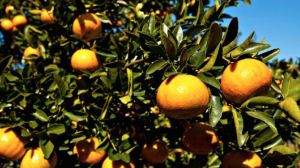By Bethany Blankley
The Center Square
February 18, 2022
Florida this year is expected to produce the smallest batch of its signature crop – oranges – since World War II.
Due to sub-freezing temperatures last month and a persistent disease infecting citrus trees, Florida citrus growers are fighting a battle on two fronts. The state, federal resources and the industry are working together to find a solution. In the meantime, as orange juice prices keep rising, citrus growers are asking Americans to keep buying it to help them stay afloat.
And they’re doing so with fewer growers.
 Florida, which produces 95% of America’s orange juice, is home to more than 400,000 acres of citrus groves. This is half the acreage of what it was 20 years ago, and 23% of existing acreage is non-bearing, Florida Citrus Mutual told ABC News Tampa Bay. Florida growers still producing are hanging on after 60% have left the industry over the past five years.
Florida, which produces 95% of America’s orange juice, is home to more than 400,000 acres of citrus groves. This is half the acreage of what it was 20 years ago, and 23% of existing acreage is non-bearing, Florida Citrus Mutual told ABC News Tampa Bay. Florida growers still producing are hanging on after 60% have left the industry over the past five years.
Still, the industry employs more than 33,000 people, provides an annual economic impact of $6.762 billion to the state, and contributes hundreds of millions of dollars in tax revenues that help support Florida’s schools, roads and health care services, the Florida Citrus Commission, which oversees the Florida Department of Citrus, reports.
The industry’s dealt with freezes before, as well as citrus canker or stasia, but citrus greening – known as the “farmer’s plague” – has proven to be persistently challenging. Citrus greening is caused by a small insect, the Asian citrus psyllid, which injects bacteria into the trees. It slowly suffocates them, causing smaller, greener, bitter fruit to grow. Over time, the trees become weaker, yield less fruit, and eventually die.
There hasn’t been a solution to stop citrus greening since it first surfaced in 2005. Researchers at the University of Florida Citrus Research and Education Center in Polk County and the University of Florida Institute of Food and Agricultural Sciences are collaborating on ways to mitigate and prevent it.
“The Florida all orange forecast, at 43.5 million boxes (1.96 million tons), is down 2 percent from the previous forecast and down 18 percent from last season’s final utilization,” the U.S. Department of Agriculture said in its February crop production forecast. “Early, midseason, and Navel varieties are forecast at 17.5 million boxes (788,000 tons), unchanged from the previous forecast but down 23 percent from last season’s final utilization. The Florida Valencia orange forecast, at 26.0 million boxes (1.17 million tons), is down 4 percent from the previous forecast and down 14 percent from last season’s final utilization.”
Florida Specialty Citrus is expected to remain at 800,000 boxes.
The report factors in temperatures falling below freezing January 28-30, but its full impact on citrus crops may not be fully reflected until March’s Crop Production report.
Despite the challenges, Florida farmers are continuing to adapt, trying new methods to keep their trees healthy. They’re also planting new trees to develop future harvests.
“The grit and determination of Florida Citrus growers does not waver. They remain committed, in the face of known and unknown challenges, to providing high-quality and great-tasting Florida Citrus and Florida Orange Juice to all who seek it out,” Shannon Shepp, executive director of the Florida Department of Citrus, said. “As consumers continue to turn to Florida Orange Juice for its health benefits at a higher rate than in many previous years, growers are reinvesting and replanting to ensure this iconic beverage can be enjoyed for generations to come.”
After the January freeze, Gov. Ron DeSantis issued an executive order to assist the agricultural industry. Those impacted by the freeze were encouraged to fill out a damage survey to determine what assistance they might be able to receive.
“As growers, we are no strangers to adversity – natural disasters, pests, and disease are all a part of daily life,” Steve Johnson, chairman of the Florida Citrus Commission, said. But the industry sticks together, he said, and the commission swiftly voted to enact an emergency rule, which lowered “the minimum ratio of total soluble solids to anhydrous citric acid requirement to 8.5 to 1 and a minimum Brix of 8 for fresh and processed oranges.” The temporary rule is in effect through March 20.
Johnson is also the owner and general manager of Johnson Harvesting, Inc., based in Wauchula. He told ABC News Action Tampa, “I hope that everybody goes home and buys a gallon of orange juice every week. We’ll make that happen some way, somehow. If it’s planting more trees, if it’s figuring out a new variety, if it’s figuring out a new root-stock, that’s what we’ll have to do.”

